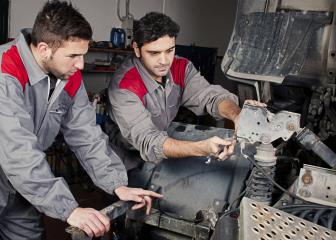An official website of the United States government
 United States Department of Labor
United States Department of Labor

This occupational group includes computer, automated teller and office machine repairers, avionics technicians, security and fire alarm systems installers, aircraft mechanics and technicians, bus and truck mechanics, diesel engine specialists, small engine mechanics, bicycle repairers, home appliance repairers, millwrights, watch repairers, wind turbine service technicians, and riggers.
The qualifications that workers need to use judgment, make decisions, interact with others, and adapt to changes in jobs.
In 2024, work was controlled by people for 87.6 percent of installation, maintenance, and repair workers, and work was self-paced for 5.9 percent.
| Requirement | Yes | No |
|---|---|---|
|
Adaptability: Work schedule variability |
51.3 | 48.7 |
|
Pace: Pause control |
70.9 | 29.1 |
|
Working around crowds |
<0.5 | >99.5 |
|
Telework |
<0.5 | >99.5 |
|
Work review: Supervising others |
10.4 | 89.6 |
|
Work review: Presence of supervisor |
50.8 | 49.2 |
|
Source: U.S. Bureau of Labor Statistics, Occupational Requirements Survey |
||
The minimum level of formal education required, credentials necessary, on-the-job training, and prior work experience necessary for average performance in jobs.
In 2024, prior work experience was required for 59.1 percent of installation, maintenance, and repair workers and on-the-job training was required for 76.4 percent.
A high school diploma was required for 64.4 percent of installation, maintenance, and repair workers.
The various tangible or concrete hazards or difficulties that are in the vicinity of where jobs’ critical tasks are performed.
In 2024, 97.1 percent of installation, maintenance, and repair workers were not exposed to extreme cold, and 93.7 percent were not exposed to extreme heat. Wetness was not present for 48.4 percent, 91.3 percent were not exposed to heavy vibrations, and 22.4 percent were not exposed to the outdoors.
Refer to the physical activities required to perform tasks in jobs. The presence and, in some cases, duration of these activities are published.
In 2024, reaching at or below the shoulder was required for 98.0 percent of installation, maintenance, and repair workers and was not required for 2.0 percent. For 3.6 percent of workers, reaching at or below the shoulder was seldom performed, for 68.7 percent reaching at or below the shoulder occurred occasionally, 25.7 percent frequently, and for less than 0.5 percent reaching at or below the shoulder occurred constantly.
Performing work in low postures was required for 95.8 percent of installation, maintenance, and repair workers and was not required for 4.2 percent.
The choice to sit or stand when performing critical tasks was available to 7.1 percent of installation, maintenance, and repair workers. On average, workers spent 18.5 percent of the workday sitting and 81.5 percent of the workday standing.
| Requirement | Yes | No |
|---|---|---|
|
Choice of sitting or standing |
7.1 | 92.9 |
|
Driving |
70.1 | 29.9 |
|
Climbing structure-related ramps or stairs |
37.8 | 62.2 |
|
Source: U.S. Bureau of Labor Statistics, Occupational Requirements Survey |
||